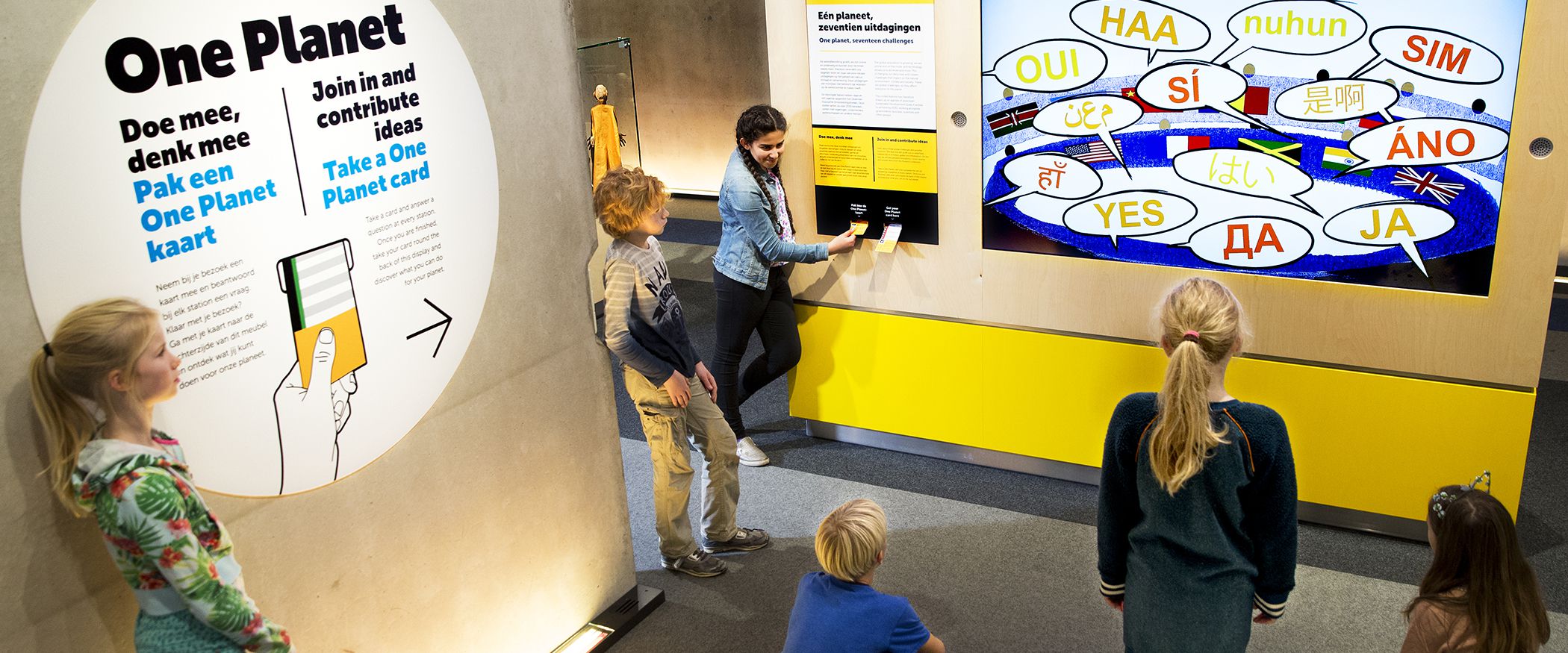Additional information about One Planet
To make the issues addressed in One Planet seem personal and relevant, displays constantly focus on a situation here in the Netherlands and then compare it with conditions elsewhere in the world. The result is a series of surprising worldwide comparisons. Visitors come away from the exhibition knowing that that they too have a valuable part to play in ensuring a sustainable future. The exhibition is structured as a presentation spread over 17 different exhibits, each relating to one of the Sustainable Development Goals. It also presents innovations, current live issues, and unusual and interesting items from the collection of the Museon.
1. No poverty
In many countries, poverty is related to poor access to energy. In the regions with the most poverty, Sub-Saharan Africa and South-East Asia, there is great potential for solar energy but it is still largely unexploited. Using solar energy in these regions could produce economic growth and personal development that would help to reduce poverty there.
What can you do?
Use UV light to discover scenes showing the power of solar energy. Find out how solar energy lamps work and see the various types. You can also watch short extracts of films on solar energy and poverty.
2. Zero hunger
If we stick to our current diet, the growth of the world population can be expected to produce a major shortage of protein-rich food. A solution must be found. In the Netherlands, we think it’s odd to eat insects, but in many other countries it’s quite usual. It’s a way of getting enough protein. Why and when would it be better to insects rather than meat, fish or eggs? What do they taste like?
What can you do?
Are you the chef of the future? Prepare virtual international dishes using different sources of protein, including locusts and seaweed.
3. Good health
Worldwide, an average of one in three adults is overweight. Obesity is a threat to public health and not just in the Western world. In many poor countries, malnourishment and obesity exist side by side. An unhealthy diet, too much snacking and too little exercise are the main causes; an increased risk of serious disease and shorter life expectancy are the consequences. Would you modify your lifestyle?
What can you do?
Get on the stepper and find out how we’ve changed our diet and reduced everyday exercise in the modern world. Prehistoric hunter-gatherers expended a lot of physical energy just finding food. Thanks to modern technology, we now work more with our heads than with our hands. And we’re constantly surrounded by tempting things to eat. It’s better for our health not to eat too much. So it’s important to get enough movement and take physical exercise.
4. Quality education
Worldwide, many children still get little or no education. Schools are too far away or too expensive. But going to school reduces the risk of poverty later in life. So education for all is the fourth sustainable development goal. Schools ought to be available to everyone. But what and how you learn is also very important. If you are taught in a language you can’t understand, you’re not likely to learn much. But learning doesn’t only happen at school. People also learn a lot outside the classroom. For example, by observing nature or listening to stories. Even playing (some) computer games can teach you a lot.
What can you do?
Play a computer game and see how modern technology can communicate traditional knowledge. Never Alone is a prizewinning computer game produced in partnership with the Iñupiat (the native people of Alaska). The Iñupiat realized that their age-old culture and knowledge was under threat from globalization and other developments. In Never Alone, computer game developers have worked with Iñupiat elders to translate that culture into a visually attractive learning game for people there and here.
5. Gender equality
Another of the sustainable development goals is to ensure equality of opportunity for children of both sexes. This can’t always be taken for granted. For example, for many girls the normal pattern is to leave school early to marry and have children. With no qualifications, they have far fewer opportunities than boys. Fortunately, more girls are now completing their education now than used to in the past.
What can you do?
Discover how different the opportunities are for the two sexes in various parts of the world. Your guides are a Dutch girl called Lotte (17) and her brother Vince (14), who come from Utrecht. Their father, Frans Hofmeester, has filmed them once a week ever since they were born, always in exactly the same way. He has edited the material to produce striking time-lapse sequences that condense their development into just a few minutes. The sequence can be stopped at any point to meet a child of the same age elsewhere in the world. How different are their lives from those of the two Dutch children? Are the two sexes ‘there’ treated the same way or differently? By meeting children/adolescents from all around the world, you discover inspiring people and projects aiming to make major improvements in the often disadvantaged position of girls.
6. Clean water and sanitation
Clean drinking water is essential to human life. The water we consume can include all sorts of undesirable things. Visible pollution like refuse, but also invisible contaminants like pesticides, sewage and medication. In the Netherlands we are lucky: clean water is always on tap. But in many other parts of the world, that’s not the case. Drinking water needs to be specially purified. That can be done in huge water purification plants, but also with simple sand filters.
What can you do?
Play the game and clean up the river. Will the river get more and more polluted or will you press the right buttons to reverse the trend? Many different things can contaminate the water and make it undrinkable. From large pieces of refuse to almost invisible microplastic and pesticides. The water can be purified using sand, bacteria, activated carbon and UV radiation. Everyone needs clean drinking water.
7. Affordable and clean energy
Fossil fuels are running out. A multitude of people are busy inventing new kinds of sustainable energy and investing in new methods of generating it. The traditional examples are wind and solar power, geothermal energy and water power (via tidal energy of hydro-electric plants). But there are lots of other attractive alternatives, as this exhibit tries to show.
What can you do?
Press the button to launch the hydrogen-powered rocket. Let yourself go, dance yourself dizzy and generate power in the process, as special floor tiles convert your kinetic energy into electricity. Do the quiz and discover the wide range of alternatives! Who knows, maybe then you too will come up with a new way to power the world…
8. Work and economic growth
The materials we need to make our mobile phones are often in scarce supply. They come from all over the world, even from conflict zones. And the people producing the phones often do so in poor working conditions. By finding out these things and being selective about what we buy, we can help to improve things.
What can you do?
Look at the inside of a phone. Discover what materials are needed to make the various parts of mobile phones and what they look like in mineral form. Put on a headset and listen to the how those minerals are obtained.
9. Innovation and infrastructure
It’s a long time since we grew all our own food. In the increasingly globalized world of today, many areas specialize in the production of single products. Food is transported all over the world. The development of shipping containers has been an important factor in this development. The transport network is still expanding. Can food transport be made more efficient and sustainable? Yes: for example, by taking action to save energy and prevent losses through transhipment, storage or decay.
What can you do?
Play a multimedia game about exports. It begins with a presentation about the way upscaling and specialization in the food production industry results in more worldwide transportation of food. Then you are invited to explore the extent of Dutch food exports by touching different foodstuffs on display. You’ll be amazed at surprising facts about foodstuffs and astonished by the export flows of basic foodstuffs going from the Netherlands around the world.
10. Reduced inequalities
There are many different reasons why people find themselves disadvantaged and excluded. For example, because they live in a developing country. Or because they are ‘different’ and in some way non-standard. Reducing the inequalities within and between countries is a major aim of the United Nations. Equality doesn’t mean that everyone has to be the same. It means that people should respect and value each others’ differences, and that everyone should have an equal chance to make something of his or her life. Is everyone equal in your eyes?
What can you do?
This exhibit challenges you to think about human diversity and discrimination. You’ll discover that we are all members of the same species. There are variations in skin colour, but absolutely no hard and fast distinction between black and white. Everyone has an individual skin tone and you can discover it via the ‘Humanae’ photo project.
Humanae is a project devised and run by Brazilian woman photographer Angélica Dass. Her aim is to photograph as many different complexions as possible and produce a series of portraits in which the background colour exactly matches the skin tone of the subject. Dass uses the worldwide PANTONE system to identify the exact shade. Humanae is a work in progress. To date, Dass has assembled over 2500 photographs, taken in 15 different cities, including Chicago, São Paulo and Addis Ababa. She says the only limit to the project is when the entire world population is part of the colossal mosaic. She’s collaborating with the Museon on her first major project in the Netherlands. The result will be an eye-catching cube covered with 100 portraits, half featuring Hague residents and the other half people from the rest of the world.
11. Sustainable cities and communities
The world has fewer and fewer populations who still live genuinely close to and in harmony with the natural world. As a result of technology and globalization, the number of such nomadic or semi-nomadic peoples in getting ever smaller. In addition, urban areas are steadily expanding. Many forest, desert and mountain-dwellers are abandoning their roots and moving to the cities. Jungle is becoming urban jungle. In twenty years’ time, the world will have 2 billion more city-dwellers. And many of the cities are really gigantic. Megacities are places with populations of more than 10 million. A megacity has a lot to offer, but there are also many problems: many residents live a long way from the centre, spend hours a day in traffic jams and breathe in a lot of smog. Some of the large- and small-scale solutions to these problems are devised by megacity residents themselves.
What can you do?
On one side of the exhibit, you can discover life in five different megacities around the world: New York, São Paulo, Lagos, Moscow and Jakarta. Five megacities on five different continents. By scanning the right cube to go with each cityscape, you activate the city concerned and get a brief audio-visual taste of life on the Moscow Metro, a market in Lagos, a São Paulo slum, etc. Then you can find out more about the city on the basis of various themes (e.g. water, waste, transport, or heritage). The current situation is described using data, photographic images, and solutions.
On the other side of the exhibit, you find out about the nomadic past and (sometimes highly contrasting) present-day lives of five different traditionally nomadic populations in five different continents: the Sami (Europe), Amazonian Indians (South America), Cree Indians (North America), San (Bushmen, Africa) and the Golok (Asia). The presentation of each population is accompanied by a historical object from the collection of the Museon and supported by high quality recent photographs.
12. Responsible consumption of resources
Unfortunately, most fishing grounds are now either totally fished out or over-fished. Fishermen often catch more than necessary, or use fishing techniques that damage the ecosystem, or catch fish that are too young. As a result, fish stocks get depleted. Sustainable fishing means using different techniques to leave the ecosystem intact, avoid bycatches and limit catch size. That way, the seas can remain an important source of food for future generations.
What can you do?
Hook a fish and read the information on the screen about the species and the way it was caught. Is it OK to eat it? If it’s over-fished, rare or inedible, it should go back into the sea. Can you make the right choice?
Almost three billion people depend on fish as a major source of food and more fish is being caught all the time. By fishing sustainably we can ensure that future generations will also be able to eat fish. Special fishing techniques, designated fishing grounds and fish quotas help to preserve species and therefore ecosystems.
13. Climate action
We burn gas, oil and coal to obtain energy, but doing so creates CO2 emissions and climate change. People around the world, from schoolchildren to world leaders, are helping to think up solutions to this problem. It is important that everyone is aware of the issue, because the more people stand up for the environment, the more pressure there will be on politicians and businessmen to come up with solutions. Many different animals are suffering because of global warming. This exhibit is about them.
What can you do?
Pick an animal that is suffering because of climate change, make a banner and take a photo of yourself with the animal. Share your photo and tell the world that you think action on climate change is important! It doesn’t matter if you choose a penguin, a horse, a panda or a seal: thousands of the world’s animal species are suffering because of climate change. If you care about the future of the planet, you can encourage other people to do the same thing. Together, we can do something about it.
14. Life below water
Coral reefs are among the most diverse ecosystems on earth. A quarter of all sea creatures live on or around reefs. But three-quarters of the world’s coral reefs are now endangered, mainly through human activities like over-fishing and pollution. Climate change is also affecting the health of reefs. To preserve coral reefs for the future, local communities need to be involved in protecting them. Research is also being done on the use of farmed coral to restore coral reefs.
What can you do?
Coral reefs are under threat but you can do something about it. This exhibits invites you to save the coral reef at four levels, each more difficult than the last. Go to the starting position and move your hand over the start button. Plants and animals live on or around coral reefs but people also dependent on them for their livelihoods and to protect coastlines. The four big threats are: over-fishing, pollution from rivers, coral bleaching and acidification of the water. These problems are all caused by man, but fortunately there are ways to solve them.
15. Life on land
Aridification and desertification are increasing due to both natural and human causes, including climate change and population pressures. Areas can no longer meet the needs of their populations. Famine and poverty result. There are various solutions, but regreening – planting new trees and protecting young trees – is a highly successful one. Belts of trees act as windbreaks, helping to stop soil blowing away and keeping it moist for longer. Trees also provide food for people and animals.
What can you do?
Turn the wheel so that the breeze from the fan blows the sand away. In arid areas, many trees get cut down because of the growing human population. As a result, there’s nothing to stop the wind and it blows the dry sand around. Sand dunes shift and the sand drifts onto cultivated fields, so that nothing can grow any more. If the soil is very dry, it’s no use planting anything anyway, because the sand and seeds will just get blown away.
Do you know how many people suffer every day because of acidification? Whether there is water in the desert? And whether deserts can be turned green again by planting trees? Find out in this quiz. Desertification is a complex problem because it has many different causes. Fortunately, there are also plenty of solutions!
16. Peace and justice
Refugees have existed since time immemorial. Not everybody has a safe and secure place to live. It’s always been that way. Some places are so unsafe that people decide to abandon house and home and look for a better life elsewhere. There are many different reasons to become a refugee, including war, poverty, discrimination and climate change.
What can you do?
This display uses items from the collection as a key part of the exhibit, not just an illustration. It presents you with challenging questions like: Are you a hero? Do you always stand up for your beliefs? Do you feel at home? You answer the questions and find out what each of them has to do with the refugee problem. Because each question relates to a specific object and story. From a railway sleeper from the notorious Burma Railway (Second World War) to the 16-year-old boy who – instead of making a faster sea crossing – walked with his dog all the way from Syria to Europe. The main point of the stories is the resilience, strength and creativity of the people concerned.
17. Partnerships for sustainable development
How can we achieve sustainable developments aimed at guaranteeing health, acceptance and a secure and sustainable planet for us all? Creating partnerships at an international or more local level and helping each other is essential. The UN finds solutions, especially in the fields of technology, trade, politics, expertise, data and monitoring. That is a lot to accomplish. But, in addition, it also has to deal with obstacles to achieving such goals within the designated period.
How would you like to help? Do you have ideals? What obstacles can you expect? What are your strengths and what could you contribute, now or in the future?
What can you do?
There are two teams in this table football game: the first is a team of players working together to achieve a UN development goal; to do that, they have to get the ball into the net. The second team, their opponents, defend the many major obstacles that prevent them from scoring.
1. Geen armoede
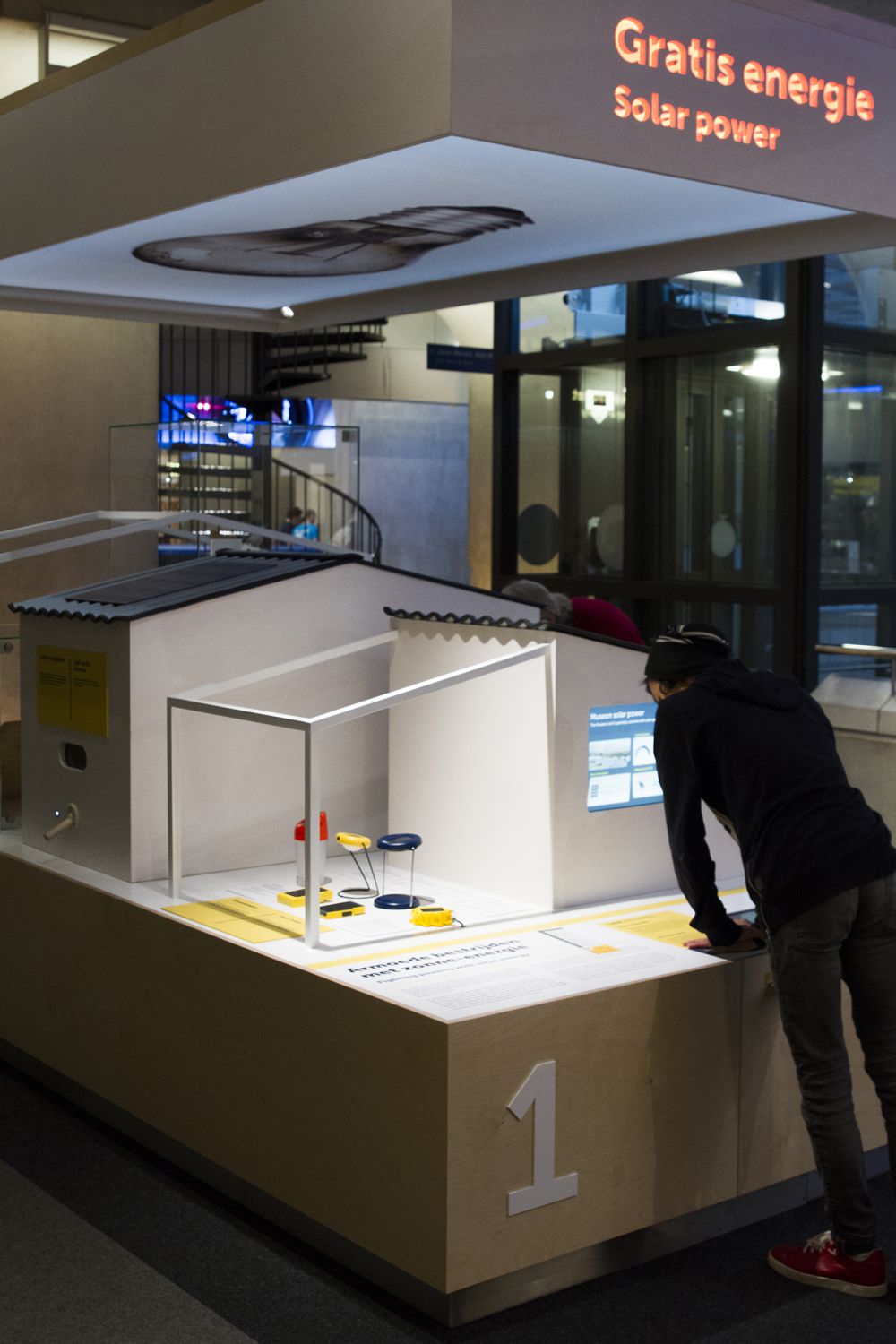
Armoede hangt in een groot aantal landen samen met slechte toegang tot energie. In de regio's met de grootste armoede (Sub-Sahara en Zuidoost Azië) is veel zonne-energie beschikbaar. Deze blijft echter grotendeels ongebruikt. De energie uit de zon kan bijdragen aan een vermindering van de armoede via economische groei en persoonlijke ontwikkeling.
Wat kun je doen?
Ontdek met UV-licht scènes waaruit de kracht van zonne-energie blijkt. Ontdek hoe lampjes op zonne-energie werken en bekijk de verschillende typen lampen. Bekijk ook korte filmfragmenten over zonne-energie en armoede.
2. Geen honger

Met ons huidige eetpatroon in combinatie met de groei van de wereldbevolking ontstaat op den duur een groot tekort aan eiwitrijk voedsel. Wat zou een oplossing hiervoor kunnen zijn? In Nederland vinden we het vreemd om insecten te eten, maar in veel andere landen is het heel gewoon. Het is een manier om aan voldoende eiwitten te komen. Waarom en wanneer zou je insecten verkiezen boven vlees, vis of eieren? En hoe smaken ze eigenlijk?
Wat kun je doen?
Ben jij de kok van de toekomst? Kook virtueel internationale gerechten met allerlei verschillende eiwitbronnen als ingrediënt zoals sprinkhanen of zeewier.
3. Goede gezondheid en welzijn
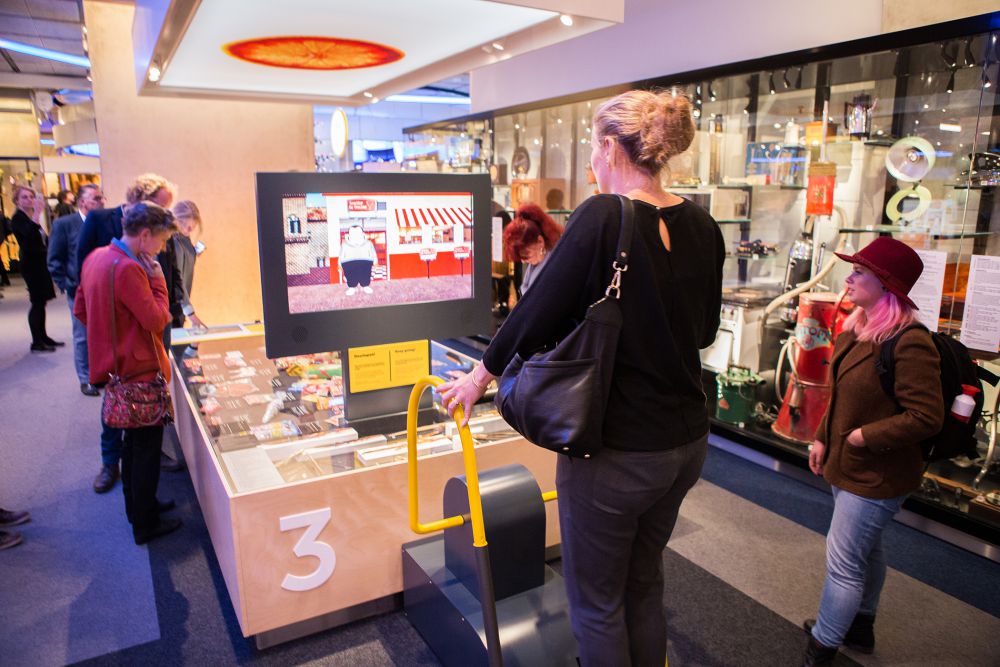
Wereldwijd is één op de drie volwassenen te zwaar. Niet alleen in de westerse wereld bedreigt obesitas de volksgezondheid. In veel arme landen komen ondervoeding en overgewicht vaak tegelijk voor. Ongezond eten, te veel tussendoortjes en te weinig beweging zijn de belangrijkste oorzaken, een grotere kans op ernstige ziekten en een korter leven zijn de gevolgen. Pas jij je levensstijl aan?
Wat kun je doen?
Stap op het stepapparaat en ontdek hoe we in de loop van de tijd anders zijn gaan eten en minder bewegen. In de oertijd kostte het jagen en verzamelen veel fysieke inspanning. Dankzij onze moderne technologie werken we meer met ons hoofd dan met onze handen. En dat terwijl er overal om ons heen lekker eten beschikbaar is! Om gezond te blijven is het beter dat je niet te veel eet. Daarnaast is het belangrijk om voldoende te bewegen en te sporten.
4. Kwaliteitsonderwijs
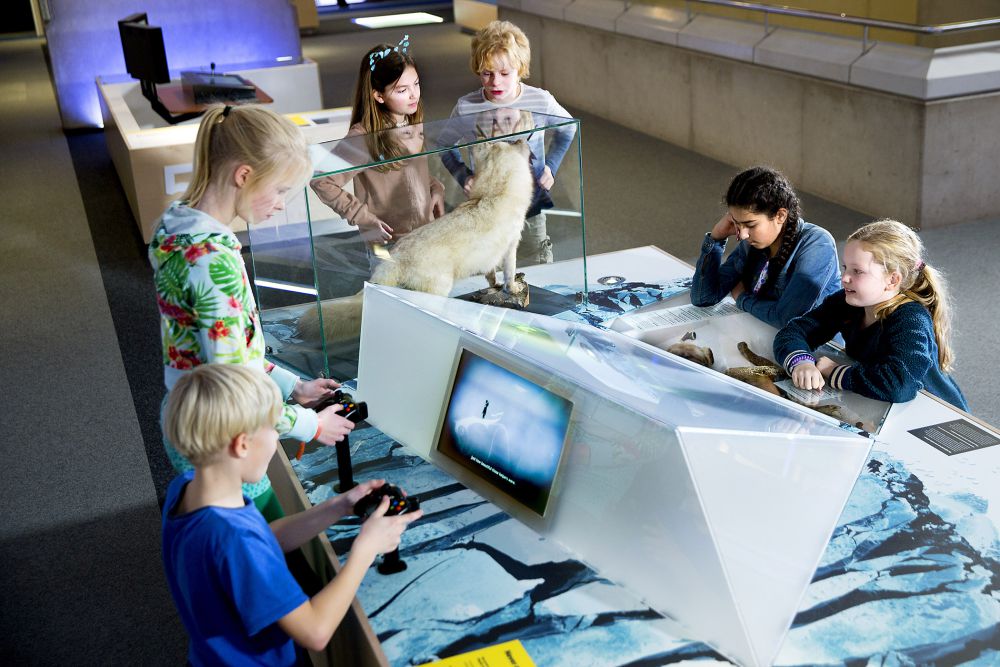
Onderwijs vergroot de kans op een leven zonder armoede. Toch zijn er wereldwijd nog steeds veel kinderen die niet of nauwelijks naar school gaan. De scholen zijn voor hen te ver weg of het onderwijs is te duur.
Onderwijs zouden toegankelijk voor iedereen moeten zijn. Maar wát en hóe je leert is ook heel belangrijk. Als je les krijgt in een taal die je niet begrijpt, zul je niet veel leren. Dat leren doe je overigens niet alleen op school. Ook buiten de muren van het schoolgebouw word je heel wat wijzer. Zo kun je in de natuur allerlei nieuwe dingen ontdekken of leer je door te luisteren naar verhalen. En ook door het spelen van games steek je soms heel wat op.
Wat kun je doen?
Je ontdekt hoe je met moderne technologie traditionele kennis kunt opdoen. Je speelt de game Never Alone. Dit internationaal bekroond computerspel werd gemaakt is in samenwerking met de Iñupiat, de oorspronkelijke bewoners van Alaska. Hun eeuwenoude cultuur en kennis dreigen te verdwijnen. In Never Alone hebben gamemakers samen met Iñupiat-ouderen deze cultuur vertaald in een oogstrelend mooi en leerzaam spel voor de mensen daar én hier.
5. Gendergelijkheid
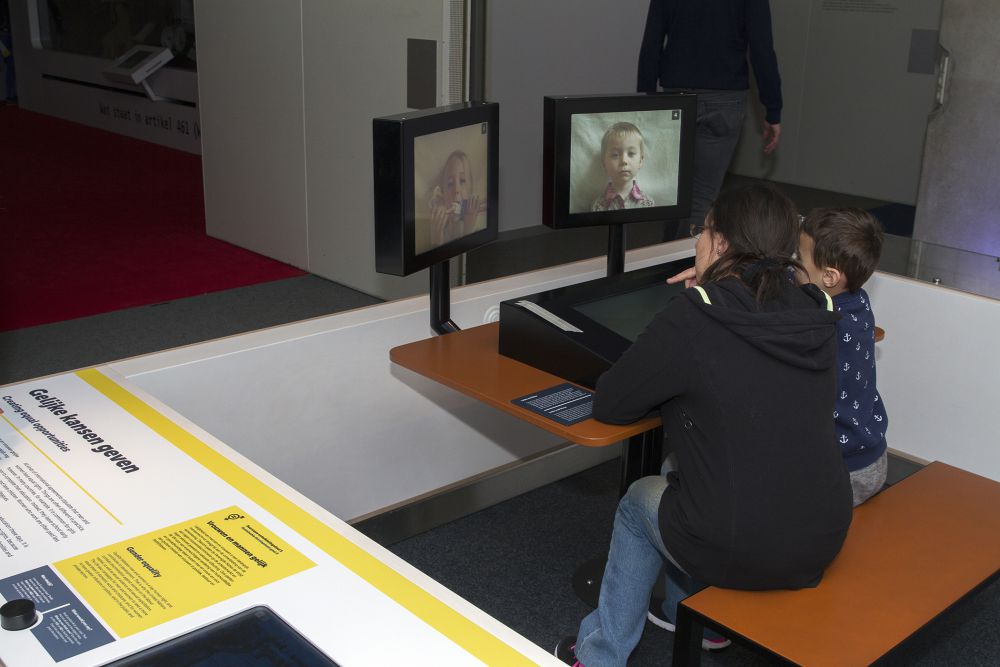
Gelijke kansen voor jongens en meisjes zijn niet altijd vanzelfsprekend. Voor veel meisjes is het bijvoorbeeld normaal dat ze hun school niet afmaken, maar vroeg trouwen en kinderen krijgen. Zonder diploma hebben ze veel minder mogelijkheden dan jongens. Gelukkig zijn er nu al meer meisjes die op school blijven dan vroeger.
Wat kun je doen?
Je ontdekt in hoeverre de kansen voor jongens en meisjes verschillend zijn op diverse plekken in de wereld. De gidsen voor deze ontdekkingstocht zijn de Nederlandse Lotte (17) en Vince (14) uit Utrecht. Sinds hun geboorte heeft hun vader, Frans Hofmeester, hen elke week op dezelfde wijze gefilmd. Op basis van dit beeldmateriaal heeft Hofmeester een timelapse gemaakt die het ouder worden van zijn kinderen treffend samenvat. In de tentoonstelling kun je de timelapse op elk moment stopzetten en kennismaken met een leeftijdsgenootje van Lotte of Vincent elders op de wereld. Hoe verschillend zijn hun levens? Je ontmoet kinderen en jongeren uit de hele wereld en maakt kennis met inspirerende personen en projecten die als doel hebben de vaak achtergestelde positie van meisjes te verbeteren.
6. Schoon water en sanitair
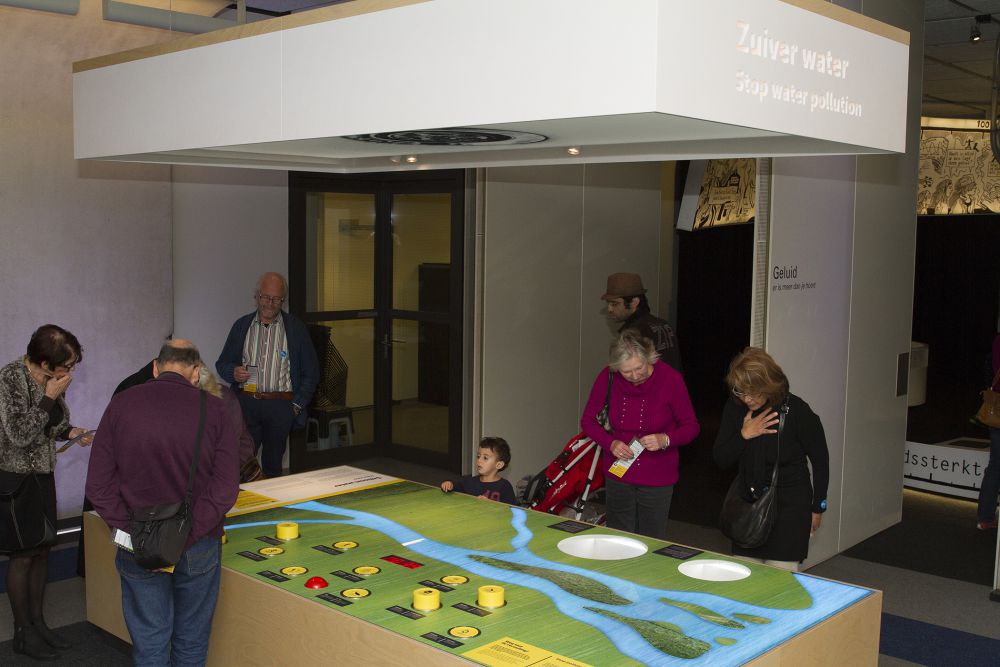
Schoon drinkwater is van levensbelang. In Nederland komt schoon water gelukkig gewoon uit de kraan, maar dat is lang niet overal op de wereld het geval. Water dat gebruikt wordt voor drinkwater moet eerst gezuiverd worden van zichtbare vervuiling zoals afval en onzichtbare vervuiling zoals bestrijdingsmiddelen, rioolwater en medicijnen. Dat kan met grote zuiveringsinstallaties, maar ook met eenvoudige zandfilters.
Wat kun je doen?
Speel het spel en maak de rivier schoon. Wordt de rivier steeds viezer of sla jij op de juiste knoppen zodat de rivier juist schoner wordt? Er zijn veel dingen die het water vervuilen waardoor het niet drinkbaar is. Van grote stukken afval tot bijna onzichtbaar microplastic en bestrijdingsmiddelen. Met zand, bacteriën, actieve kool en UV-straling wordt het water gezuiverd.
7. Betaalbare en duurzame energie
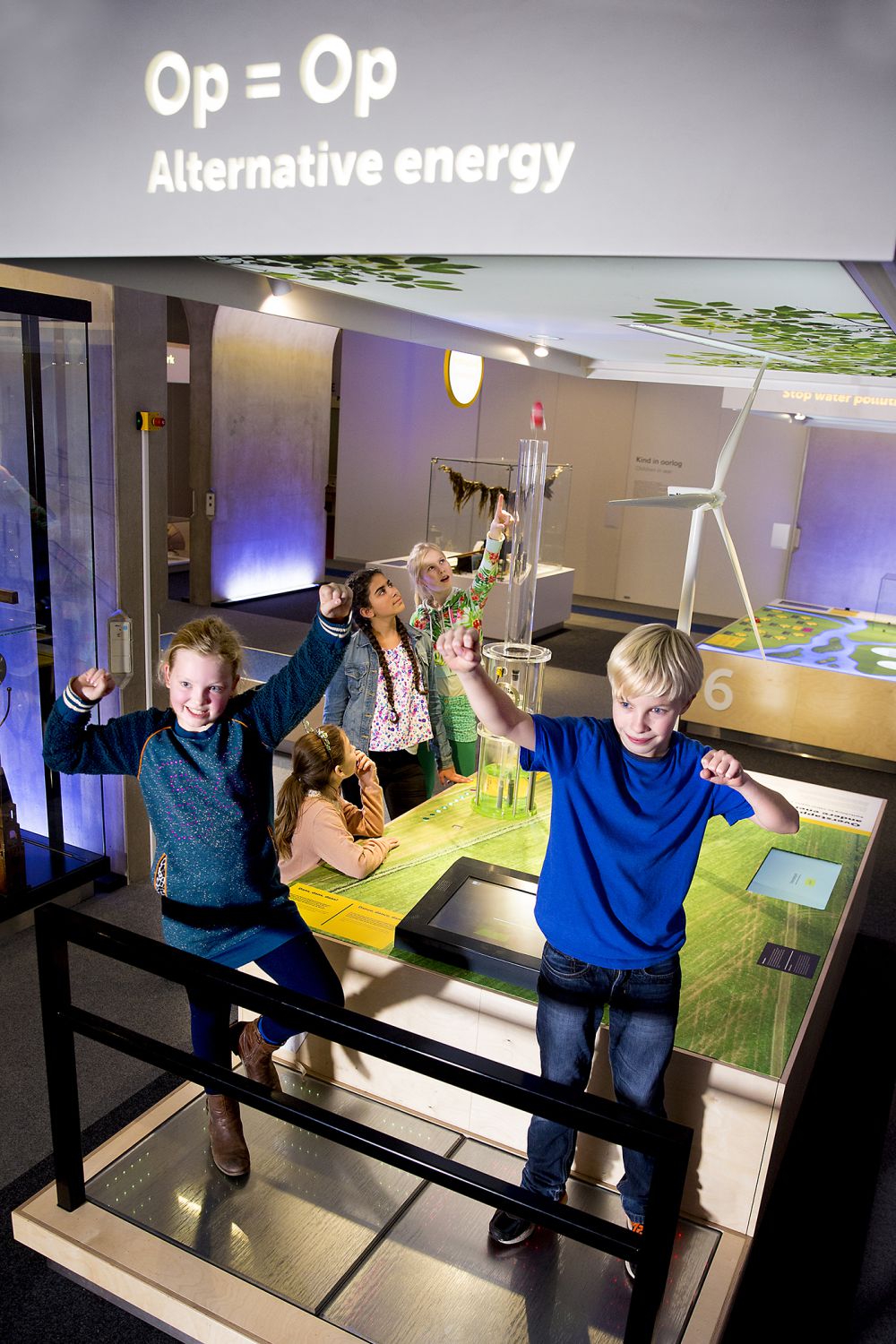
De fossiele brandstoffen raken op. Daarom wordt overal geïnvesteerd in duurzame energie: zonne-energie, windenergie, geothermische energie en waterkrachtcentrales. Daarnaast zijn er een heleboel andere, leuke alternatieven, die we in de tentoonstelling laten zien.
Wat kun je doen?
Druk op de knop en de waterstofraket gaat de lucht in. Of dans de sterren van de hemel en zorg op die manier voor energie. De speciale vloertegels zetten jouw dansenergie om in stroom. Speel de quiz en ontdek wat er allemaal kan! Wie weet bedenk jij daarna zelf een nieuwe manier om de wereld van energie te voorzien…
8. Waardig werk en economische groei
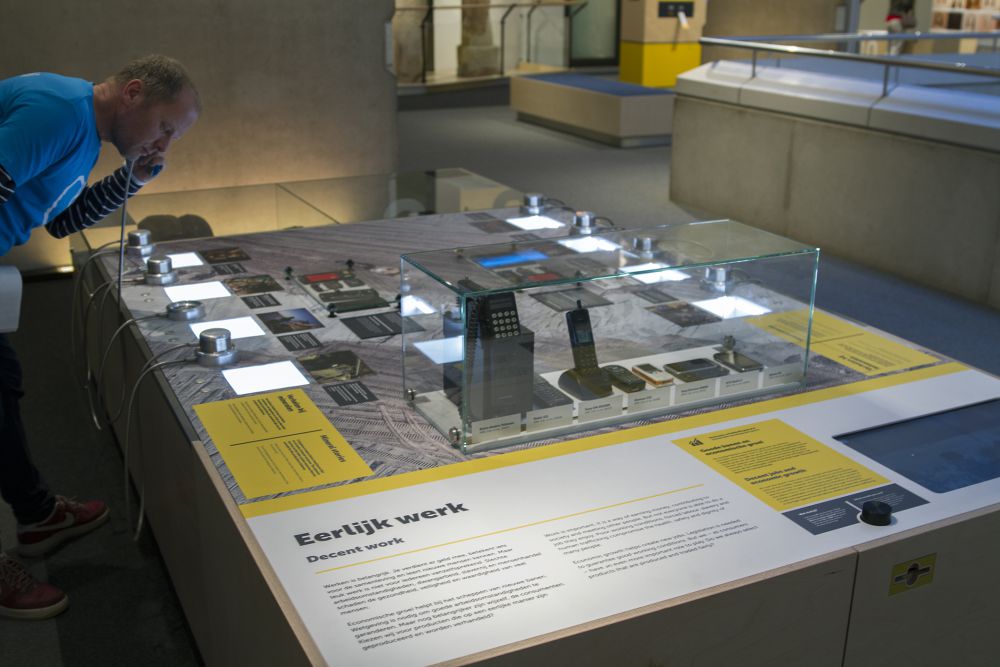
De grondstoffen die we nodig hebben voor onze mobiele telefoons zijn vaak schaars en komen van over de hele wereld, zelfs uit conflictgebieden. De productie van de apparaten gebeurt vaak onder slechte arbeidsomstandigheden. Door ons goed te laten informeren en selectief te zijn bij aankopen, kunnen we dat tegengaan.
Wat kun je doen?
Bekijk de binnenkant van een telefoon. Ontdek de grondstoffen die nodig zijn voor de verschillende onderdelen en luister naar het verhaal achter de grondstofwinning.
9. Industrie, innovatie en infrastructuur
De tijd dat we ons eigen voedsel verbouwden ligt ver achter. In de geglobaliseerde wereld van nu specialiseren veel streken zich in een bepaald product. Voedseltransport vindt dan ook over de hele wereld plaats. Het transportnetwerk breidt zich nog altijd uit. Kan het efficiënter en duurzamer? Ja, bijvoorbeeld door energiebesparing en het tegengaan van verliezen bij overslag, opslag of door bederf.
Wat kun je doen?
Op een grote tafel wordt een interactief spel over de Nederlandse voedselexport gepresenteerd. Verken de reikwijdte van deze voedselexport en laat je verrassen door allerlei wetenswaardigheden.
10. Ongelijkheid verminderen
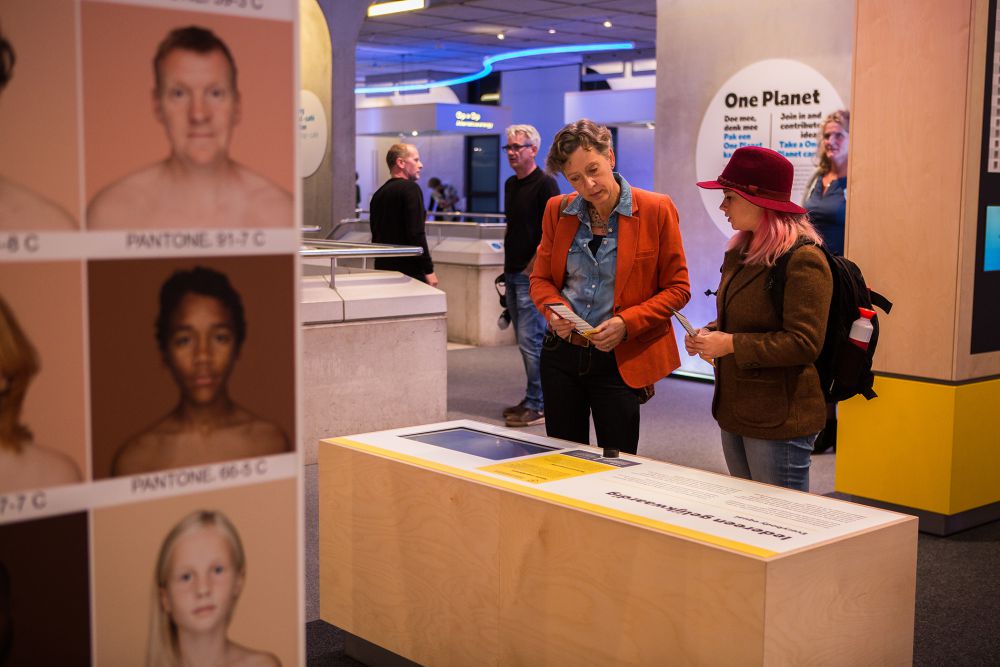
Mensen kunnen om een heleboel redenen worden achtergesteld en buitengesloten. Bijvoorbeeld omdat ze in een ontwikkelingsland wonen. Of omdat ze ‘anders’ zijn en niet voldoen aan de heersende opvattingen. Het verminderen van de ongelijkheid is een belangrijk doel van de Verenigde Naties. Gelijkheid betekent niet dat alle mensen hetzelfde zouden moeten zijn. Het betekent dat mensen elkaars verschillen respecteren en waarderen en dat iedereen dezelfde kansen krijgt om wat van het leven te maken. Is voor jou iedereen gelijk?
Wat kun je doen?
In de tentoonstelling word je op confronterende wijze uitgedaagd na te denken over menselijke verschillen en discriminatie. Mensen verschillen van huidskleur, maar van een strikte scheiding tussen zwart en wit is in het geheel geen sprake. Iedereen heeft zijn eigen kleur en ontdekt dat door middel van het fotoproject Humanae van de Braziliaanse fotografe Angélica Dass. Het is een serie portretten waarvan de achtergrondkleur overeenkomt met de huidskleur van de geportretteerden. Voor het bepalen van de kleurtoon maakt Dass gebruik van het wereldwijd gebruikte PANTONE-systeem. Humanae is werk in uitvoering. Anno 2021 bestaat het uit meer dan vierduizend foto’s, gemaakt in 36 steden in twintig landen. Volgens Dass is er pas een limiet bereikt als de gehele wereldpopulatie deel is geworden van dit kolossale mozaïek. De samenwerking met het Museon was haar eerste grote project in Nederland. Het resultaat is een spraakmakende kubus met daarop honderd portretten; circa vijftig daarvan zijn inwoners van Den Haag, de andere helft bestaat uit mensen uit de rest van de wereld.
11. Duurzame steden en gemeenschappen
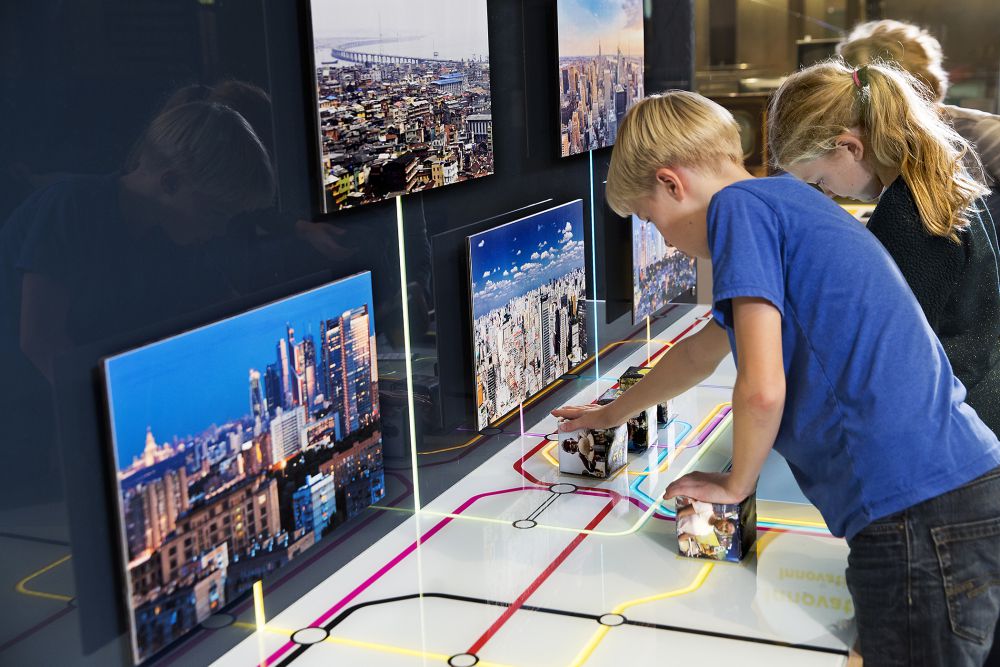
In de wereld zijn er steeds minder volken die nog echt en met de natuur leven. Als gevolg van technologische ontwikkeling en globalisering wordt deze groep van nomaden en seminomaden steeds kleiner. Bovendien breiden steden zich steeds verder uit. Veel oorspronkelijke bewoners van bossen, woestijnen en bergen trekken naar de stad. Jungle wordt stadsjungle. Over twintig jaar wonen er wereldwijd 2 miljard meer mensen in een stad of zelfs megastad. Megasteden zijn plaatsen met meer dan 10 miljoen inwoners. Een megastad heeft veel te bieden, maar er zijn ook veel problemen, zoals slechte woningen, luchtvervuiling en verkeersopstoppingen. Grote en kleine oplossingen voor deze problemen worden mede bedacht door de inwoners van de megastad zelf.
Wat kun je doen?
Maak kennis met het leven in de megasteden New York, São Paulo, Lagos, Moskou en Jakarta. Scan de juiste kubus bij het juiste stadsgezicht en waan je voor eventjes in de metro van Moskou, op een markt in Lagos of een sloppenwijk in São Paulo. Of loop naar de andere kant van het tentoonstellingsmeubel en maak aan de hand van voorwerpen en foto’s kennis met het nomadische verleden en de huidige realiteit van de Saami (Europa), Amazone-indianen (Zuid-Amerika), Cree-indianen (Noord-Amerika), San (Afrika) en Golok (Azië).
12. Verantwoorde consumptie en productie
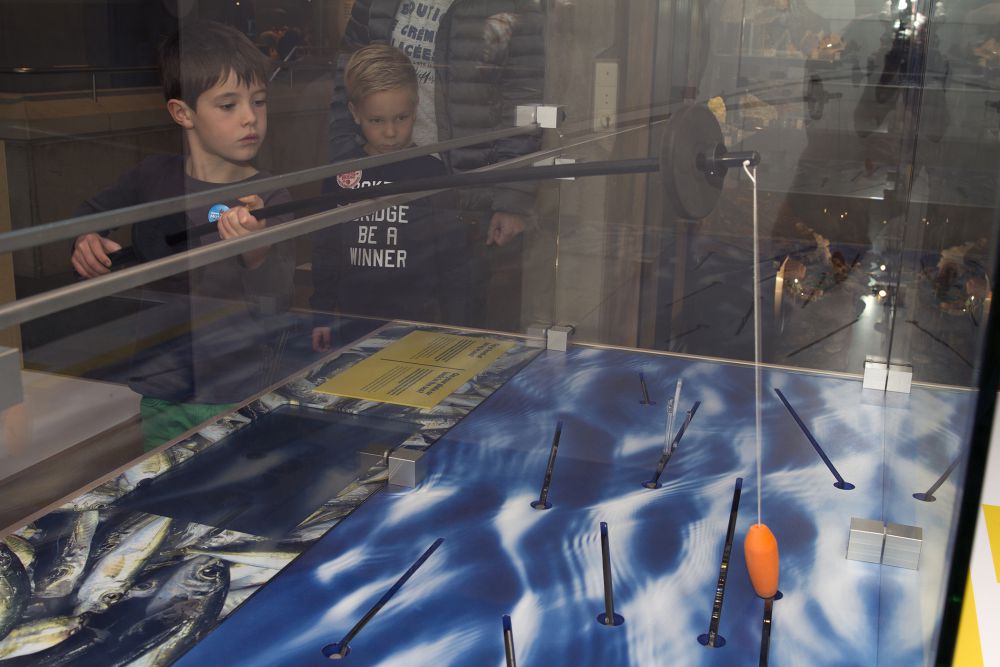
Helaas zijn de meeste visgronden volledig bevist of overbevist. Vaak wordt er meer gevangen dan nodig is, zijn de gebruikte vistechnieken schadelijk voor het ecosysteem of zijn de gevangen vissen te jong. Daardoor gaan visbestanden achteruit. Bij duurzame visserij worden andere technieken gebruikt zodat de leefomgeving van vissen intact blijft, bijvangst wordt voorkomen. Ook wordt er niet teveel gevangen. Zo blijft de oceaan ook voor toekomstige generaties een belangrijke voedselbron.
Wat kun je doen?
Hengel een vis omhoog. Op een beeldscherm zie je informatie over de vis en de wijze waarop deze gevangen is. Mag hij op je bord? Is hij overbevist, zeldzaam of wordt hij niet gegeten, dan moet hij terug in de zee. Maak jij de juiste keuze?
13. Klimaatactie
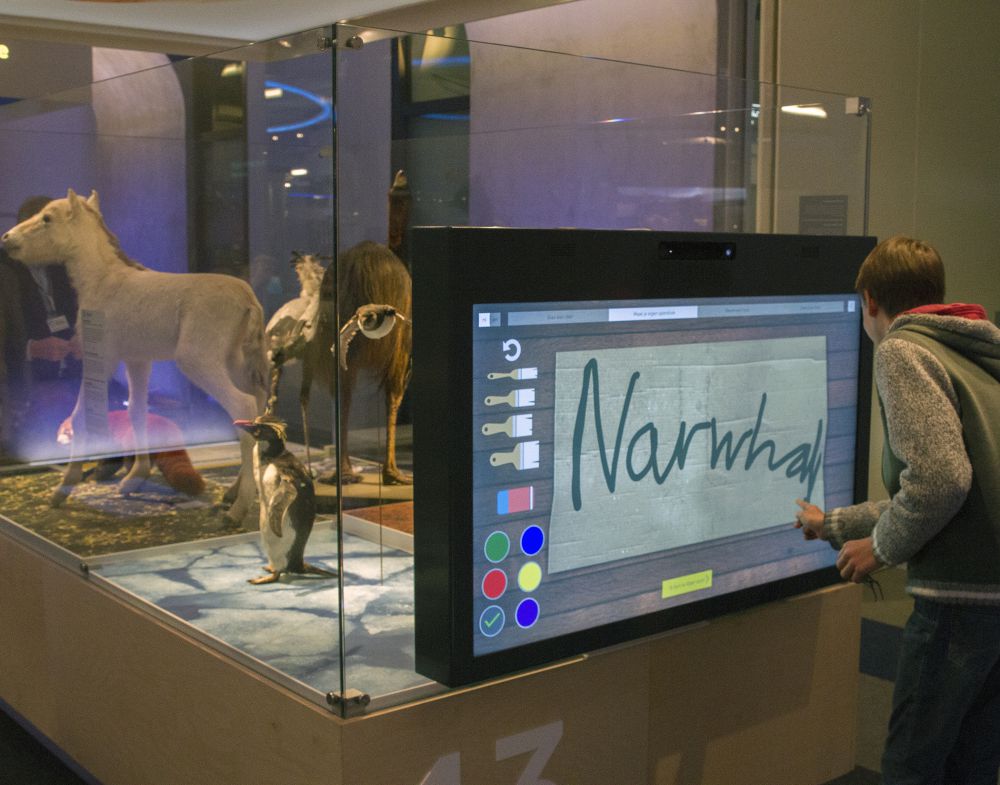
We verbranden gas, olie en kolen om energie te krijgen, maar daardoor komt CO2 vrij en verandert het klimaat op aarde. Mensen over de hele wereld denken mee aan een oplossing hiervoor, van schoolkinderen tot wereldleiders. Het is belangrijk dat iedereen weet dat dit probleem speelt, want als veel mensen opkomen voor ons milieu, móeten de politiek en het bedrijfsleven wel met oplossingen komen.
Wat kun je doen?
Er zijn veel dieren die last hebben van de opwarming van de aarde. Die dieren staan hier centraal. Kies één van deze dieren, maak een spandoek en zet jezelf op de foto met het dier. Deel je foto en laat de wereld weten dat jij klimaatactie belangrijk vindt! Of je een pinguïn, paard, panda of zeehond kiest, het maakt niet uit: duizenden dieren op aarde hebben last van klimaatverandering. Als jij je het lot van de aarde aantrekt, kun je andere mensen aanmoedigen om dat ook te doen. Samen kunnen we er wat aan doen.
14. Leven in het water
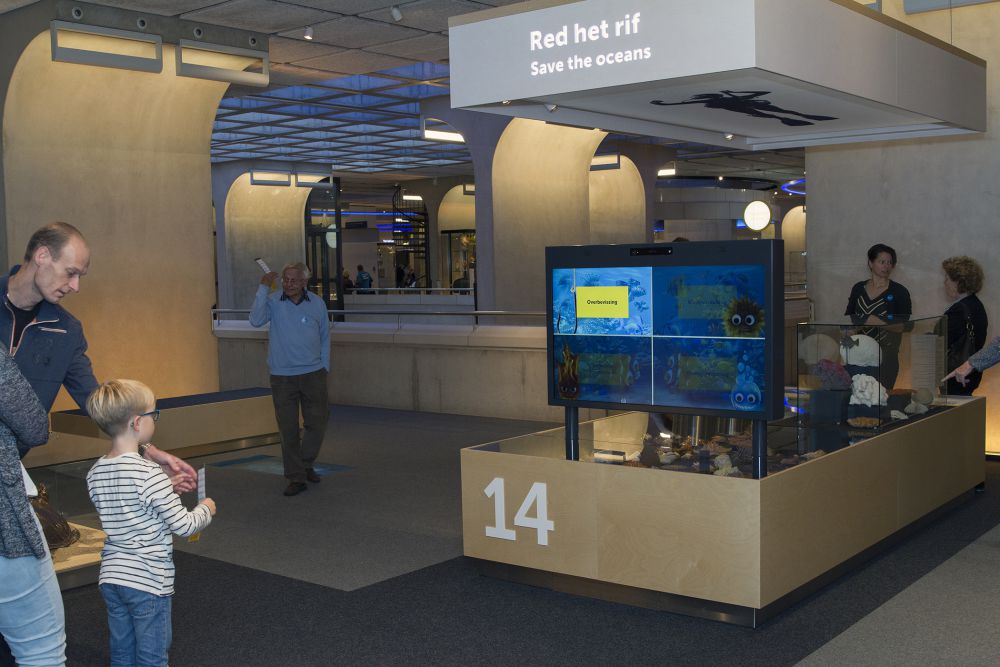
Koraalriffen behoren tot de meest soortenrijke ecosystemen op aarde. Van alle zeedieren leeft 25 procent in het rif. Ook voor de mens zijn koraalriffen belangrijk. Veel mensen zijn voor hun levensonderhoud afhankelijk van de koraalriffen. Bovendien dragen de riffen bij aan de kustbescherming.
Wereldwijd wordt echter driekwart van de koraalriffen bedreigd, met name door menselijke activiteiten als overbevissing en vervuiling. Ook klimaatverandering heeft nadelige gevolgen voor de gezondheid van het rif. Om de koraalriffen voor de toekomst te behouden moeten lokale gemeenschappen bij de bescherming van het rif betrokken worden. Ook wordt er onderzoek naar het restaureren van koraalriffen met gekweekt koraal gedaan.
Wat kun je doen?
Het koraalrif wordt bedreigd, maar jij kunt daar wat aan doen. Op vier niveaus, die steeds moeilijker worden, ga je het koraalrif redden. Ga op de juiste plaats op de vloer staan en beweeg je hand naar de startknop. De vier grote bedreigingen zijn: overbevissing, vervuiling vanuit rivieren, verbleking van koraal en verzuring van het water. Deze problemen worden door de mensen veroorzaakt, maar gelukkig zijn er ook mogelijkheden om ze op te lossen.
15. Leven op het land

Door natuurlijke en menselijke oorzaken als klimaatverandering en bevolkingsdruk nemen verdroging en verwoestijning toe. Gebieden kunnen niet langer voorzien in de levensbehoeften van bewoners, met honger en armoede tot gevolg. Een succesvolle oplossing is regreening: het planten van nieuwe bomen en het beschermen van jonge boompjes. Boomgordels breken de wind waardoor de aarde minder snel wegwaait en langer vochtig blijft. Ook leveren bomen voedsel voor mens en dier.
Wat kun je doen?
Draai aan het wiel zodat de wind van de ventilator het zand weg kan blazen. In droge gebieden zijn veel bomen gekapt, omdat er steeds meer mensen zijn komen wonen. Daardoor heeft de wind vrij spel en verstuift het zand. Zandduinen verplaatsen zich en het zand dat wegwaait komt op de akkers terecht waardoor er niks meer kan groeien. Als de grond heel droog is, kun je daar ook niets planten omdat de zaadjes wegwaaien.
Weet jij hoeveel mensen er elke dag last hebben van verdroging? Of er water is in de woestijn? Dit ontdek je in een quiz. Gelukkig zijn er veel oplossingen voor verwoestijning!
16. Vrede, justitie en sterke publieke diensten
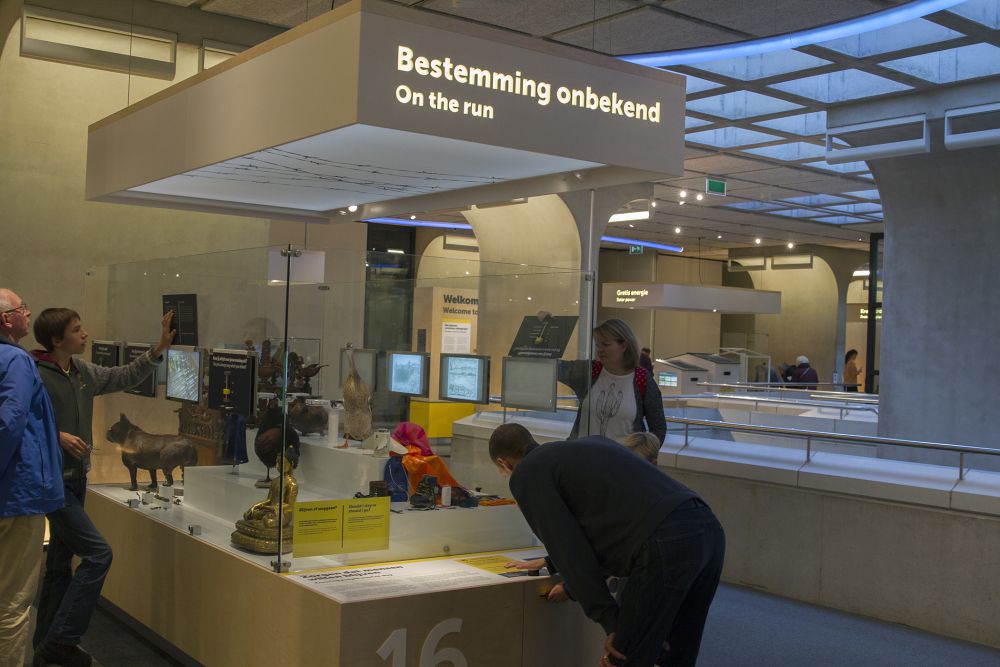
Vluchtelingen zijn er sinds mensenheugenis. Een veilige en goede leefomgeving was en is niet voor iedereen vanzelfsprekend. Op sommige plekken is het dusdanig onveilig dat mensen besluiten huis en haard achter te laten en te vluchten. Er kunnen verschillende redenen zijn om te vluchten, zoals oorlog, armoede, discriminatie of klimaatverandering.
Wat kun je doen?
Op een grote vitrine met voorwerpen uit de museumcollectie staan prikkelende vragen. Ben jij een held? Kom je altijd voor je mening uit? Voel jij je thuis? Elke vraag is verbonden met een bepaald object in de vitrine én met het verhaal van een vluchteling. Door de vragen te beantwoorden maak je kennis met verhalen van vluchtelingen. Waarom hebben ze huis en haard achtergelaten? De veerkracht en creativiteit van mensen staan in deze verhalen centraal.
17. Partnerschap om de doelstellingen te bereiken
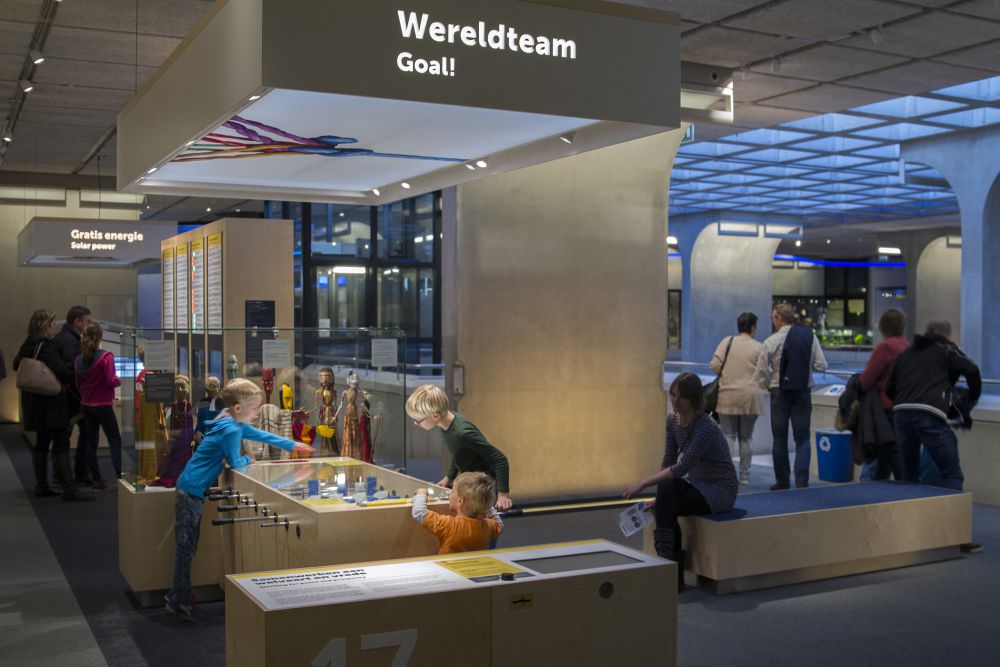
Wat hebben we nodig om de andere zestien doelstellingen te behalen? Samenwerking natuurlijk! Zonder samenwerking op het gebied van techniek, handel, kennis, onderzoek etc. zijn de Duurzame Ontwikkelingsdoelen ver weg. Alleen door samenwerking kunnen we de hindernissen opruimen die het behalen van de doelen in de weg staan.
Wat kun je doen?
In de tentoonstelling staat een speciaal tafelvoetbalspel. Je speelt met twee teams. Het ene team probeert de Duurzame Ontwikkelingsdoelen te behalen door zoveel mogelijk doelpunten te scoren. Het andere team probeert er juist voor te zorgen dat de doelen niet worden behaald en er geen doelpunten worden gescoord. Net echt, want ook bij het behalen van de Duurzame Ontwikkelingsdoelen hebben we met een heleboel hindernissen te maken.

